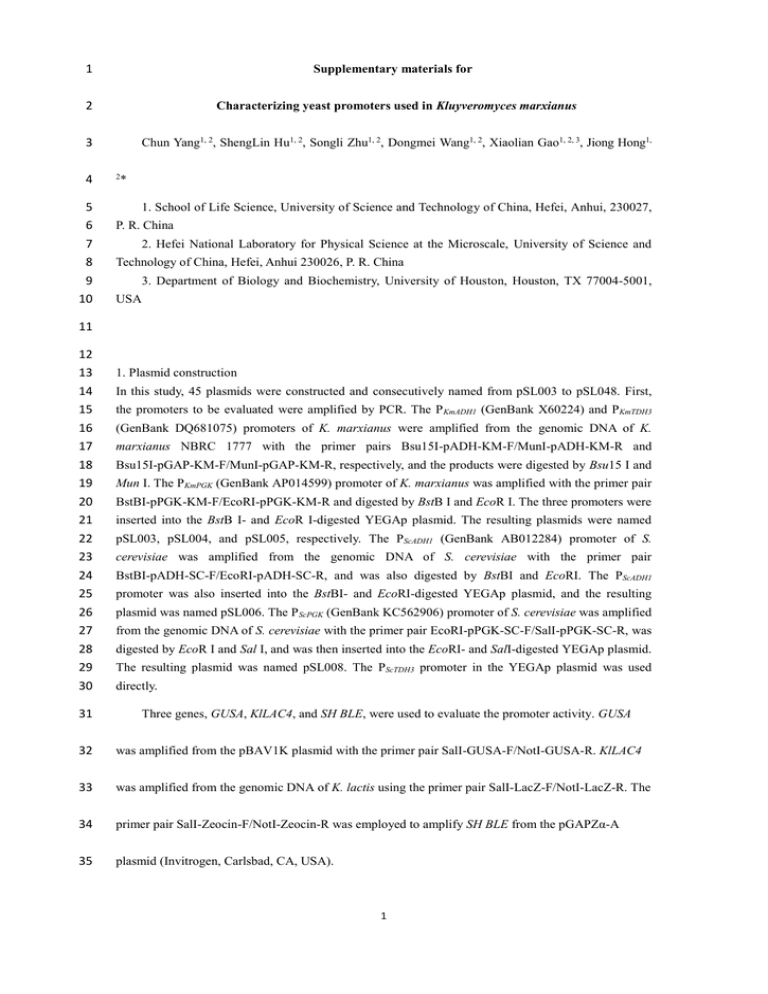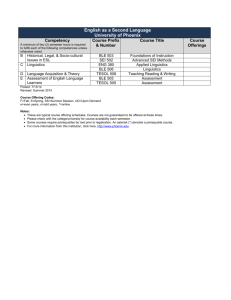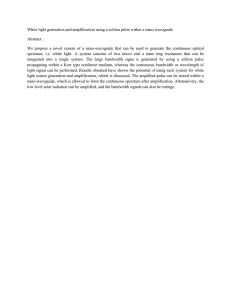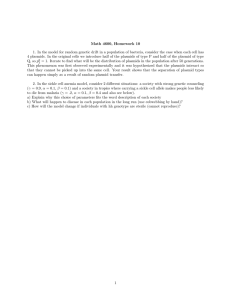1 2 3 4
advertisement

1 Supplementary materials for 2 Characterizing yeast promoters used in Kluyveromyces marxianus 3 Chun Yang1, 2, ShengLin Hu1, 2, Songli Zhu1, 2, Dongmei Wang1, 2, Xiaolian Gao1, 2, 3, Jiong Hong1, 4 5 6 7 8 9 10 2 * 1. School of Life Science, University of Science and Technology of China, Hefei, Anhui, 230027, P. R. China 2. Hefei National Laboratory for Physical Science at the Microscale, University of Science and Technology of China, Hefei, Anhui 230026, P. R. China 3. Department of Biology and Biochemistry, University of Houston, Houston, TX 77004-5001, USA 11 12 13 14 15 16 17 18 19 20 21 22 23 24 25 26 27 28 29 30 31 1. Plasmid construction In this study, 45 plasmids were constructed and consecutively named from pSL003 to pSL048. First, the promoters to be evaluated were amplified by PCR. The P KmADH1 (GenBank X60224) and PKmTDH3 (GenBank DQ681075) promoters of K. marxianus were amplified from the genomic DNA of K. marxianus NBRC 1777 with the primer pairs Bsu15I-pADH-KM-F/MunI-pADH-KM-R and Bsu15I-pGAP-KM-F/MunI-pGAP-KM-R, respectively, and the products were digested by Bsu15 I and Mun I. The PKmPGK (GenBank AP014599) promoter of K. marxianus was amplified with the primer pair BstBI-pPGK-KM-F/EcoRI-pPGK-KM-R and digested by BstB I and EcoR I. The three promoters were inserted into the BstB I- and EcoR I-digested YEGAp plasmid. The resulting plasmids were named pSL003, pSL004, and pSL005, respectively. The PScADH1 (GenBank AB012284) promoter of S. cerevisiae was amplified from the genomic DNA of S. cerevisiae with the primer pair BstBI-pADH-SC-F/EcoRI-pADH-SC-R, and was also digested by BstBI and EcoRI. The PScADH1 promoter was also inserted into the BstBI- and EcoRI-digested YEGAp plasmid, and the resulting plasmid was named pSL006. The PScPGK (GenBank KC562906) promoter of S. cerevisiae was amplified from the genomic DNA of S. cerevisiae with the primer pair EcoRI-pPGK-SC-F/SalI-pPGK-SC-R, was digested by EcoR I and Sal I, and was then inserted into the EcoRI- and SalI-digested YEGAp plasmid. The resulting plasmid was named pSL008. The PScTDH3 promoter in the YEGAp plasmid was used directly. Three genes, GUSA, KlLAC4, and SH BLE, were used to evaluate the promoter activity. GUSA 32 was amplified from the pBAV1K plasmid with the primer pair SalI-GUSA-F/NotI-GUSA-R. KlLAC4 33 was amplified from the genomic DNA of K. lactis using the primer pair SalI-LacZ-F/NotI-LacZ-R. The 34 primer pair SalI-Zeocin-F/NotI-Zeocin-R was employed to amplify SH BLE from the pGAPZα-A 35 plasmid (Invitrogen, Carlsbad, CA, USA). 1 36 The DNA obtained from these three genes was digested by SalI and NotI, and was then inserted 37 into SalI- and NotI-digested pSL003, pSL004, pSL005, pSL006, pSL008, and YEGAp plasmids, 38 respectively. The resulting plasmids were named with consecutive numbers from pSL009 to pSL026, 39 as shown in Table S2. All the fragments, including the promoter, gene, and terminator, were amplified 40 with the primer pair GAP-stuI-F/GAP-stuI-R and inserted into the pKmLEU2 MscI site. The resulting 41 plasmids were named consecutively from pSL027 to pSL044 and they were used as the template for the 42 amplification of integrated expression cassette. A map of the constructed plasmids was shown in Fig. 43 S1 and the selection marker, promoter and gene used for evaluation of the plasmids were shown in 44 Table S2. 45 An α-amylase gene from Aspergillus oryzae was expressed under promoters PScTDH3 and PKmPGK to 46 confirm the obtained information. The ORF of AoAMY gene (GenBank Acesssion No. 47 XM_003189571.1) was amplified from YEGAp-AoAMY (pSL045) (Wang et al. 2014) with primer 48 pair AoAMY- EcoRI-F/ AoAMY-NotI-R (Table S1). After the DNA fragment was digested by EcoR I 49 and Not I, it was inserted into EcoR I and Not I digested pSL005. The resulting plasmids were named as 50 pSL046. The expression cassettes from pSL045 and pSL046 were amplified using primer pair 51 GAP-StuI-F/GAP-StuI-R and inserted into the pKmLEU2 MscI site. The resulting plasmids were 52 named pSL047 and pSL048, and were used as the templates for the amplification of integrated 53 expression cassette. 54 55 2. Construction of the strains integrated the expression cassettes at KmLEU2 locus of genome 56 After the integrative plasmids listed in Table 2S were constructed and the expression cassettes 57 including KmLEU2, promoters and genes were amplified by PCR using the primer pair 58 KmLEU2-F/KmLEU2-R, the expression cassettes were transformed into K. marxianus YHJ 010 by the 2 59 lithium acetate method (Abdel-Banat et al. 2010; Yanase et al. 2010). The transformants were selected 60 on SD medium supplemented with uracil and tryptophan. The obtained transformants were inoculated 61 into 5 mL YPD, and the genomic DNA was extracted as previously described (Zhang B et al. 2011). 62 The strains in which expression cassettes were homologously integrated on the KmLEU2 locus were 63 screened through PCR with genomic DNA of transformants as template (Fig. S2). For SH BLE, GUSA, 64 KlLAC4 65 Leu961F/Leu2881R and EcoRI-AoAMY-F/GAP -StuI-R were used, respectively. The primer pairs and 66 the corresponding strains are listed in Table S1. and AoAMY, the primer pairs SalI-Zeocin-F/Leu260R, 67 3 SalI-GUSA-F/Leu260R, 68 69 70 71 72 Fig. S1 Plasmid map used to evaluate the promoter. The “Promoter” indicated in the map was P KmADH1, 73 PKmTDH3, PKmPGK, PScADH1, PScTDH3, or PScPGK, and the “Gene” in the map was SH BLE, GUSA, KlLAC4 or 74 AoAMY. The expression cassettes were inserted into the KmLEU2 (black arrow line) and divided the 75 KmLEU2 into two parts. The fragments including KmLEU2, promoter, gene, and terminator T ScTDH3 can 76 be amplified by the primers KmLEU2-F and KmLEU2-R (small arrow) for integration. The plasmids 77 with various combinations of promoters and genes are listed in Table S2. 78 79 4 80 81 82 83 84 85 86 87 88 89 90 91 92 93 94 95 96 97 Fig. S2 Confirmation of site-directed integration of expression at KmLEU2 locus. The arrow indicates the results of positive clones. The integration at KmLEU2 locus of SH BLE (A), GUSA (B), KlLAC4 (C) and AoAYMY (D) were confirmed by PCR and detected by the size change of amplified products. A 1.8 Kb PCR products confirmed that SH BLE expression cassette correctly integrated using primers SalI-Zeocin-F/Leu260R; for GUSA, the size was 3.4 Kb products which confirmed the correctly integrated using primers SalI-GUSA-F/Leu260R. For the longest KlLAC4 gene, the primers Leu961F/Leu2881R were used, and the size of PCR product was 6.0 Kb due to the insertion of KlLAC4 expression cassette in KmLEU2 locus,otherwise both 2.8 Kb and 6Kb products would appeared. 1.7 Kb PCR products using primers EcoRI-AoAMY-F/GAP-StuI-R should be detected if the AoAMY expression cassette was correctly integrated. Other products with various fragments were unspecific PCR product. For each strain, at least three clones were obtained for analysis 98 99 100 101 102 103 104 Fig. S3 Determination of the amylase activity through halo assay on soluble starch plate and quantitative determination of the activity in culture supernatant. (A) Halo assay at 30°C; (B) Halo assay at 42°C; (C) the amylase activity in culture supernatant. 5 105 Table S1 Primers used in this study Primers Sequences (5’->3’)* Application Bsu15I-pADH1-KM-F ATCGATCGATCCGAGTGGCATGATTCGCGCAG K. marxianus ADH1 promoter amplification MunI-pADH1-KM-R ATCGCAATTGTGTGTGTATGATTTTGTTT K. marxianus ADH1 promoter amplification Bsu15I-pGAP-KM-F ATCGATCGATGCATGCCCATTACCCGGAATAT K. marxianus TDH3 promoter amplification MunI-pGAP-KM-R ATCGCAATTGTGTGATGTGTAAAAGTGTGTGT K. marxianus TDH3 promoter amplification BstBI-pPGK-KM-F ATCGTTCGAAGGAGCACGATATCTTGGTCATTGC K. marxianus PGK promoter amplification EcoRI-pPGK-KM-R ATCGGAATTCCATTTTTGTATCTTTATATAGGTAG K. marxianus PGK promoter amplification BstBI-pADH1-SC--F GGGTTCGAATCTAGCTCCCTAACATGTAGGTGG S. cerevisiae ADH1 promoter amplification EcoRI-pADH1-SC-R: GGGGAATTCTGTATATGAGATAGTTGATTGTATG S. cerevisiae ADH1 promoter amplification EcoRI-pPGK-SC-F: GGGGAATTCCATGGCGGGCATGTATCATTGCCCT S. cerevisiae PGK promoter amplification SalI-pPGK-SC-R: GGGGTCGACTGTTTTATATTTGTTGTAAAAAGTA S. cerevisiae PGK promoter amplification SalI-GUSA-F GGGGTCGACGAAACGATGGGCAGCAGCCATCACCAT GUSA amplification CATC NotI-GUSA-R ATGCGCGGCCGCCTACCGGCCGCATAGGCCTTGTTTG GUSA amplification SalI-Lac-F: GGGGTCGACGAAACGATGTCTTGCCTTATTCCTGAGA KLLAC4 amplification ATT NotI-Lac-R: ATGCGCGGCCGCTTATTCAAAAGCGAGATCAAACTCA KLLAC4 amplification SalI-Zeocin-F GGGGTCGACGAAACGATGGcCAAGTTGACCAGTGCC SH BLE amplification GTTC NotI-Zeocin-R ATGCGCGGCCGCTCAGTCCTGCTCCTCGGCCACGAA SH BLE amplification G AoAMY-EcoRI-F ACGTGAATTCATGATGGTCGCGTGGTGGTCTC AoAMY amplification AoAMY-NotI-R ATAAGAATGCGGCCGCTTACGAGCTACTACAGATCTT AoAMY amplification GCTACC 106 107 GAP-stuI-F GAGAAGGCCTACCAGTTCTCACACGGAACACCAC Expression cassette amplification GAP-stuI-R GAGAAGGCCTTCAATCAATGAATCGAAAATGTC Expression cassette amplification KmLEU2-F AGAAGAGTCATATAGCCAAAGAACC Expression cassette amplification KmLEU2-R CATGGTTTTGCGAGTTAAGTC Expression cassette amplification RT-kmACT1-F CCCAATGAACCCAAAGAATAACAG For RT-PCR of ACT1 RT-kmACT1-R GATAGCATGAGGCAAGGAGAAACC For RT-PCR of ACT1 RT-Zeocin-R GCGCTGATGAACAGGGTCACGTCG For RT-PCR of SH BLE RT-Zeocin-F CCAAGTTGACCAGTGCCGTTCCGGT For RT-PCR of SH BLE RT-LAC4-F CAGGAAGACTGGAAGTACGGTAAAC For RT-PCR of KLLAC4 RT-LAC4-R CCATTAACATAAAGCTCGTAACAATTGTC For RT-PCR of KlLAC4 RT-GUSA-R ACATCGGCTTCAAATGGCGTATAGC For RT-PCR of GUSA RT-GUSA-F ATCAGTTCGCCGATGCAGATATTCG For RT-PCR of GUSA Leu260R CATATGCGAGTCCATTATGTCCTTCT For integration confirmation Leu961F GAATCACCAGAATGGCTGCATTTTTAGC For integration confirmation Leu2881R GTTGGAAGAGGCTATCAGACCAGAC For integration confirmation *underlined sequences indicate the restriction enzyme site 6 108 Table S2 Plasmids used in this study Plasmids Selection marker Promoter Gene Reference YEGAp pKmLEU2 pSL003 pSL004 pSL005 pSL006 pSL008 pSL009 pSL010 pSL011 pSL012 pSL013 pSL014 pSL015 pSL016 pSL017 pSL018 pSL019 pSL020 pSL021 pSL022 pSL023 pSL024 pSL025 pSL026 pSL027 pSL028 pSL029 pSL030 pSL031 pSL032 pSL033 pSL034 pSL035 pSL036 pSL037 pSL038 pSL039 pSL040 pSL041 pSL042 pSL043 pSL044 ScTRP1 KmLEU2 ScTRP1 ScTRP1 ScTRP1 ScTRP1 ScTRP1 ScTRP1 ScTRP1 ScTRP1 ScTRP1 ScTRP1 ScTRP1 ScTRP1 ScTRP1 ScTRP1 ScTRP1 ScTRP1 ScTRP1 ScTRP1 ScTRP1 ScTRP1 ScTRP1 ScTRP1 ScTRP1 KmLEU2 KmLEU2 KmLEU2 KmLEU2 KmLEU2 KmLEU2 KmLEU2 KmLEU2 KmLEU2 KmLEU2 KmLEU2 KmLEU2 KmLEU2 KmLEU2 KmLEU2 KmLEU2 KmLEU2 KmLEU2 PScTDH3 PKmADH1 PKmTDH3 PKmPGK PScADH1 PScPGK PKmADH1 PKmADH1 PKmADH1 PKmTDH3 PKmTDH3 PKmTDH3 PKmPGK PKmPGK PKmPGK PScADH1 PScADH1 PScADH1 PScTDH3 PScTDH3 PScTDH3 PScPGK PScPGK PScPGK PKmADH1 PKmADH1 PKmADH1 PKmTDH3 PKmTDH3 PKmTDH3 PKmPGK PKmPGK PKmPGK PScADH1 PScADH1 PScADH1 PScTDH3 PScTDH3 PScTDH3 PScPGK PScPGK PScPGK GUSA KLLAC4 SH BLE GUSA KLLAC4 SH BLE GUSA KLLAC4 SH BLE GUSA KLLAC4 SH BLE GUSA KLLAC4 SH BLE GUSA KLLAC4 SH BLE GUSA KLLAC4 SH BLE GUSA KLLAC4 SH BLE GUSA KLLAC4 SH BLE GUSA KLLAC4 SH BLE GUSA KLLAC4 SH BLE GUSA KLLAC4 SH BLE (Hong et al. 2007) (Hong et al. 2007) This study This study This study This study This study This study This study This study This study This study This study This study This study This study This study This study This study This study This study This study This study This study This study This study This study This study This study This study This study This study This study This study This study This study This study This study This study This study This study This study This study 7 pSL045 pSL046 pSL047 pSL048 ScTRP1 ScTRP1 KmLEU2 KmLEU2 PScTDH3 PKmPGK PScTDH3 PKmPGK AoAMY AoAMY AoAMY AoAMY 109 8 (Wang et al. 2014) This study This study This study 110 Table S3 Yeast strains used in this study Strains Relevant genotype Reference K. marxianus NBRC 1777 YHJ 010 Wild type NBRC1777; (Hong et al.2007) ΔKmUra3::Kanr, ΔKmLeu2::HisG, (Hong et al.2007) ΔKmTrp1::HisG YYC 027 YHJ 010; KmLEU2; PKmADH1-GUSA This study YYC 028 YHJ 010 ; KmLEU2; PKmADH1-KLLAC4 This study YYC 029 YHJ 010; KmLEU2; PKmADH1-SH BLE This study YYC 030 YHJ 010; KmLEU2; PKmTDH3-GUSA This study YYC 031 YHJ 010; KmLEU2; PKmTDH3-KLLAC4 This study YYC 032 YHJ 010; KmLEU2; PKmTDH3-SH BLE This study YYC 033 YHJ 010; KmLEU2; PKmPGK-GUSA This study YYC 034 YHJ 010; KmLEU2; PKmPGK-KLLAC4 This study YYC 035 YHJ 010; KmLEU2; PKmPGK-SH BLE This study YYC 036 YHJ 010; KmLEU2; PScADH1-GUSA This study YYC 037 YHJ 010; KmLEU2; PScADH1-KLLAC4 This study YYC 038 YHJ 010; KmLEU2; PScADH1-SH BLE This study YYC 039 YHJ 010; KmLEU2; PScTDH3-GUSA This study YYC 040 YHJ 010; KmLEU2; PScTDH3-KLLAC4 This study YYC 041 YHJ 010; KmLEU2; PScTDH3-SH BLE This study YYC 042 YHJ 010; KmLEU2; PScPGK-GUSA This study YYC 043 YHJ 010; KmLEU2; PScPGK-KLLAC4 This study YYC 044 YHJ 010; KmLEU2; PScPGK-SH BLE This study YYC 045 YHJ 010; KmLEU2 This study YYC 046 YHJ 010; KmLEU2; PScTDH3-AoAMY This study YYC 047 YHJ 010; KmLEU2; PKmPGK-AoAMY This study 111 112 9 113 114 115 116 117 118 119 120 121 122 123 124 125 126 127 128 129 130 131 132 References Abdel-Banat BMA, Nonklang S, Hoshida H, Akada R (2010) Random and targeted gene integrations through the control of non-homologous end joining in the yeast Kluyveromyces marxianus. Yeast 27:29-39 Hong J, Wang Y, Kumagai H, Tamaki H (2007) Construction of thermotolerant yeast expressing thermostable cellulase genes. Journal of Biotechnology 130:114-123 Wang RL, Wang DM, Gao XL, and Hong J (2014) Direct fermentation of raw starch using a Kluyveromyces marxianus strain that expresses glucoamylase and alpha-amylase to produce ethanol. Biotechnology Progress 30(2): p. 338-347 Yanase S, Hasunuma T, Yamada R, Tanaka T, Ogino C, Fukuda H, Kondo A (2010) Direct ethanol production from cellulosic materials at high temperature using the thermotolerant yeast Kluyveromyces marxianus displaying cellulolytic enzymes. Applied Microbiology and Biotechnology 88:381-388 Zhang B, Zhang L, Wang DM, Gao XL, Hong J (2011) Identification of a xylose reductase gene in the xylose metabolic pathway of Kluyveromyces marxianus NBRC1777. Joural of Industrial Microbiology & Biotechnology 38:2001-2010 133 134 10






